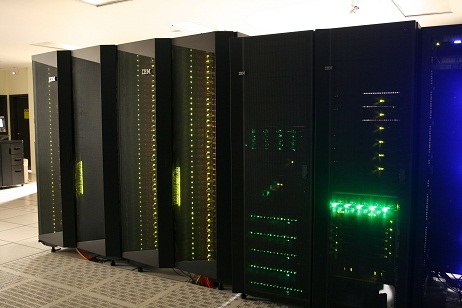Upgrade Triples Computational Capability of Razor Supercomputer

Razor II helps researchers explore the fundamental properties of chemicals and nanomaterials, new methods of detecting breast cancer and many other specialized problems.
FAYETTEVILLE, Ark. – Student and faculty researchers at the University of Arkansas will benefit from a substantial hardware upgrade to Razor, the flagship supercomputer of the Arkansas High Performance Computing Center. The upgrade is funded by a $900,000 grant from the National Science Foundation and significantly increases the computer’s computational capability, said Rick McMullen, who was recently named the center’s new director.
“The Razor cluster is a major asset for U of A researchers,” McMullen said. “This upgrade brings world-class computing power to the university and the state and makes us more competitive as a research intensive institution.”
The upgrade occurred as a result of a multidisciplinary research project to provide better tools for computational science across the University of Arkansas campus. Four researchers – principal investigator Douglas Spearot, associate professor of mechanical engineering, and co-principal investigators Jackson Cothren, associate professor of geosciences; Magda El-Shenawee, professor of electrical engineering; and Peter Pulay, professor of chemistry – submitted the NSF grant proposal.
The original Razor system, which was activated in early 2011, featured 126 dual hex-core processor units with a processing capability of 17.75 teraflops, or one trillion floating point operations per second. The phase II expansion – now called Razor II – added 113 dual oct-core processor units with a capability of 37.67 teraflops. As a whole, the system now boasts a total of 3,320 computer cores and 55.35 trillion floating point calculations per second.
“In other words, we’ve tripled our computational capability,” said Jeff Pummill, manager of cyberinfrastructure enablement for the center. “To give you a sense of how powerful this is, it would take more than 40,000 years for a human to calculate a trillion floating point operations on a manual calculator.”
The Arkansas High Performance Computing Center supports research in computer science, integrated nanoscience, computational chemistry, computational biomagnetics, materials science and spatial science. Faculty and students from a growing number of departments at the university use high performance computing resources to explore the fundamental properties of chemicals and nanomaterials, complex problems in phylogenetics and genomics, new methods of detecting breast cancer, the organization of large sets of spatial data and many other specialized problems.
For example, the computational power of Razor II helped physics professor Salvador Barraza-Lopez on a project designed to understand how pinching a graphene membrane changes its electronic properties. To do this, Barraza-Lopez and his research collaborator wanted to increase the number of atoms in a molecular dynamics simulation by more than one order of magnitude, a task that greatly increased the computational demand for the problem.
“This was possible only because I had direct access to 1,600 processors,” Barraza-Lopez said. “The textures needed were generated by Razor II in less than one day, a task that would have taken about ten days of continuous computing at a normal, shared-resources facility.”
Although scientific computing is indispensible in disciplines such as chemistry, physics and engineering, researchers in other disciplines are turning to high performance computing to meet their analysis and simulation needs, as well, McMullen said.
“We are seeing more non-traditional users from fields such as geography, biological and agricultural engineering and business take advantage of computing resources and expertise offered by the center,” McMullen said. “We expect to see greater use by biologists, sociologists and medical researchers as well.”
The Arkansas High Performance Computing Center is funded by grants from the National Science Foundation and the Arkansas Science and Technology Authority. The center’s resources may be used by any faculty member or student at the University of Arkansas or other Arkansas universities that are members of the Arkansas Research and Educational Optical Network, or ARE-ON.
McMullen, the former director of research computing at the University of Kansas, has served as director of the Arkansas High Performance Computing Center since Aug. 13. As a scientist and technology strategist, McMullen has spent more than 20 years in high performance computing research and technical management. His positions have included work on strategic technology evaluation and planning in both the private sector and higher education. He has focused his career on developing and applying novel information and communication technologies to solve problems in computationally intensive and data-intensive research. In addition to serving as director of the Arkansas High Performance Computing Center, McMullen is a faculty member in the College of Engineering’s department of computer science and computer engineering.
Topics
Contacts
Rick McMullen, director
Arkansas High Performance Computing Center
479-575-8681,
dfmcmull@uark.edu
Matt McGowan, science and research communications officer
University Relations
479-575-4246,
dmcgowa@uark.edu
Headlines
Four Students Named Goldwater Scholars; Two Earn Udall Honorable Mentions
Four U of A students have received the prestigious Goldwater Scholarship, an award for top students in mathematics, science, and engineering.
Cross-Campus Collaboration Culminates in New Outdoor Geological Installation
Grand opening event to celebrate the new GeoLab installation at the U of A’s Gearhart Hall courtyard is set for May 3. The installation will be open to the public year-round.
First Students to Use Online Degree to Hone Nursing Leadership, Elevate Patient Care
Hanna Baxendale and Wendi Kimbrell will begin coursework in the Doctor of Nursing Practice-Executive Master of Business Administration program offered by the Eleanor Mann School of Nursing and Walton College.
Join the Office for Sustainability on a Final Cruise to Campus
Cruise to Campus Wednesdays have fostered a gathering space for individuals interested in biking to campus. Drop by the Old Main Lawn from 7:30-10 a.m. Wednesday for coffee, something to eat and conversation.
Fay Jones School Student Ambassador Program Gives Voice to Design Students
The student ambassador program at the Fay Jones School of Architecture and Design is built to connect top design students with their school, its alumni, its future students and others inside and outside the school.




